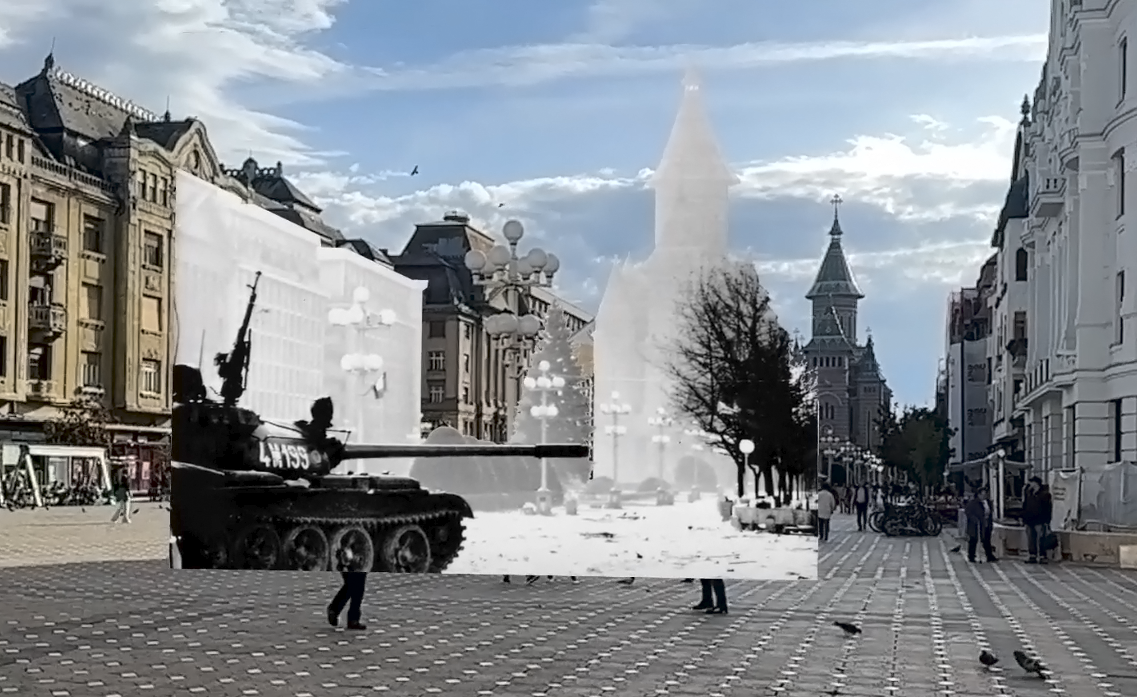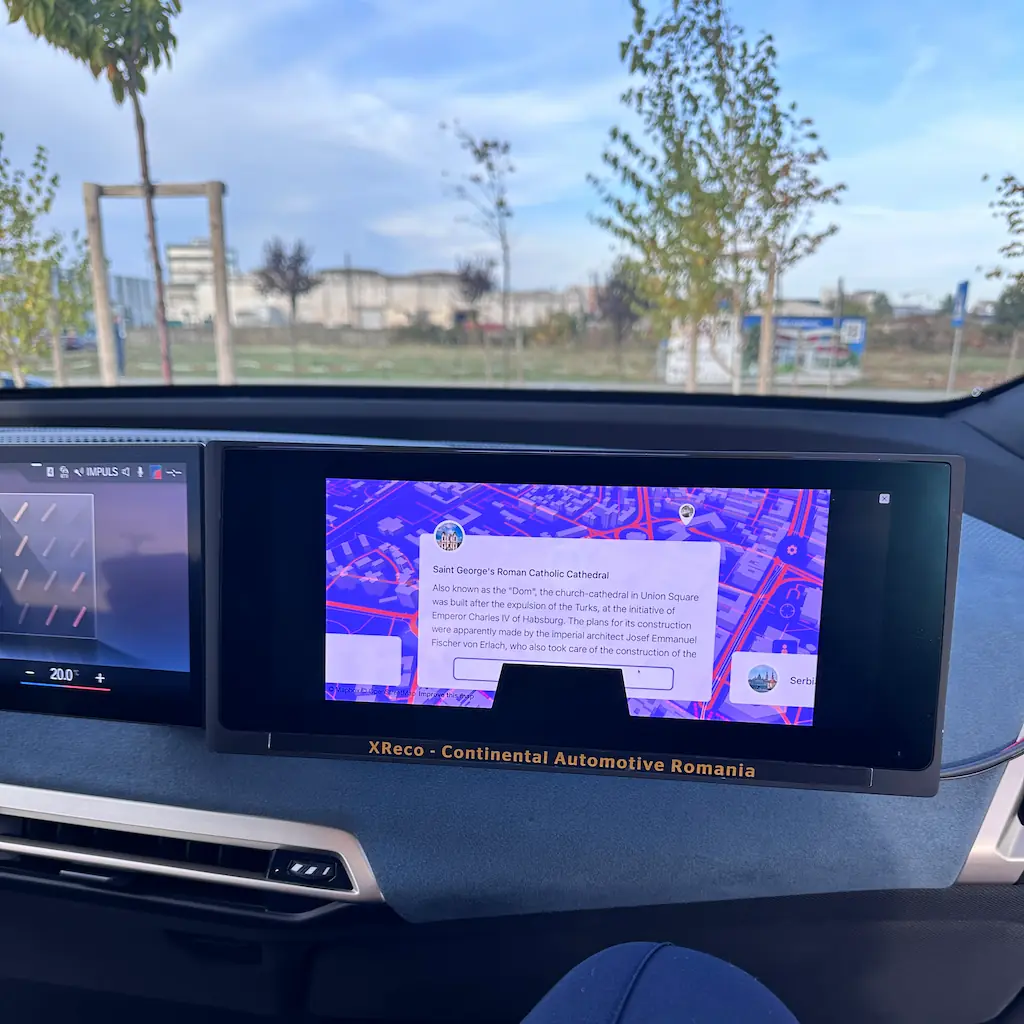As part of the EU-funded XReco project, ZAUBAR is developing an augmented reality (AR) tourism experience in Timisoara, Romania, in collaboration with leading automotive supplier Continental. To do this, they are combining cultural storytelling with spatial data processing. The result: a journey in which passengers explore history without leaving the car.
A City That Comes to Life While You Drive
It begins with a quiet drive through Timisoara – once the epicentre of the revolution, today a city of culture and architectural beauty. But for the passengers of a connected car, the journey is transformed into something extraordinary.
As the car glides past Victory Square, AR visualisations fill the infotainment screen in the car. Voices from 1989 are heard softly, merging historical recordings with today’s surroundings. Around the corner, St George’s Cathedral rises up in a digital reconstruction, and its baroque features explained by an AI-controlled tour guide. The National Theatre pulsates with amplified light and invites you to explore behind the windscreen. This is not a simulation. It is a new kind of tourism – intimate, informative and interactive.

Figure 1: AR Experience: An army tank in the deserted main town square in Timisoara, Romania, on December 24, 1989, opposite the Orthodox Cathedral, where the start of the demonstration began seven days before, when Ceausescu special polce killed more than 2,000 people. (AP Photo/Vranic)
The Barrriers AR Still Faces
Despite the great interest in augmented reality (AR) in 2025, AR is still limited by technical friction. High-quality content requires specific technical tools, expert teams and has long creation processes. The predominant file format, GLTF, often clashes with and most AR apps require downloads that deter casual users before the experience even begins.
Museums, cities and cultural institutions have countless historical and cultural stories, but not the infrastructure to make them available to tourists via AR. Even small updates to digital content can be risky and expensive because a single broken link can ruin an entire tour.
And location-based installations often remain undiscovered because tourists do not use the AR offer intuitively. There is a lack of awareness of AR experiences, or the user experience is not intuitive.

Figure 1: Nearby location-based augmented reality station on Continental’s in-car infotainment system.
ZAUBAR’s Breakthrough Approach In The XReco Project
ZAUBAR realised that the problem was not the potential of AR, but the manufacturing process behind it. So they changed the rules. They introduced AI-powered creation tools that transform ordinary photos and videos into impressive AR scenes, immersive AR scenes. The result: content production costs are reduced by up to 75% and creators don’t need to have any programming skills. Then they have removed a major obstacle – app downloads – by offering WebAR. Experiences load instantly in a browser, whether on a mobile device or an infotainment screen. Just one tap, and the story begins.
A robust open-source CMS powers the platform behind the scenes and enables real-time updates, whether for an AR city tour, an AR exhibition or in-car infotainment screens. Creators can change their content without risking downtime or hiring technical staff.
And then there are ZAUBAR’s spatial agents – AI-guided narrators with centimetre precision.
They personalise each tour by adapting to the user’s location and what they see, making history feel local and alive. This has been proven to increase visitor dwell time by 15 minutes.
Cutting-Edge Tech Meets Cultural Depth
In the Timisoara project, these innovations are put into action. Powered by Neural Radiance Fields (NeRF), landmarks are rendered with cinematic realism. Volumetric video allows real people—historians, performers, guides—to appear within the experience. Generative AI creates mural-like visuals that respond to the environment, enhancing both engagement and aesthetics. Whether accessed through a car’s dashboard or a visitor’s smartphone, the AR experience is seamless and striking. It invites curiosity and encourages connection—two things that define meaningful travel.
Testing, Scaling, and What Comes Next
Timisoara pilot project is part of the XReco project for the automotive and tourism sector. ZAUBAR’s CMS is an integral part of the XReco platform, which simplifies the production of AR experiences such as the Timisoara AR project for creators without programming skills.
In May, the XReco project will enter the user testing phase to gather feedback on the usability, historical accuracy, technical performance and, most importantly, the cost-effectiveness of such AR applications. These learnings will flow into the finalisation of the XReco platform. The CMS will also be further developed in this way and extended to other cities and countries.
Tutorial about ZAUBAR´s CMS in the XReco platform.
About ZAUBAR in the XReco Project
ZAUBAR is a Berlin-based B2B SaaS company specialising in AI-powered augmented reality experiences for brands, agencies and cultural institutions. Its platform enables the creation and monetisation of immersive AR content around the world. As part of the Horizon-funded European project XReco, ZAUBAR is leading the realisation of Demonstrator 2, which explores the integration of XR technologies in the tourism and automotive sectors. This includes the development of mobile XR experiences and in-car AR for self-driving applications, using state-of-the-art tools such as generative AI, NeRF and intuitive authoring systems. ZAUBAR’s contribution to XReco is an example of how immersive storytelling can leave the confines of news media and enter public spaces, vehicles and cities – all while maintaining regulatory compliance, user accessibility and industry integration.


Follow XReco!